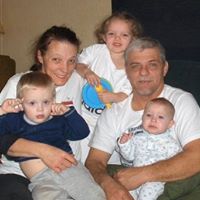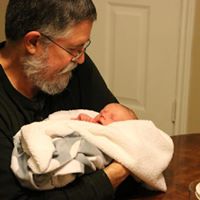David Lockard
age ~49
from Tempe, AZ
- Also known as:
-
- Donald Lockard
- Deborah Lockard
- Phone and address:
- 1250 W Grove Pkwy APT 1150, Tempe, AZ 85283
David Lockard Phones & Addresses
- 1250 W Grove Pkwy APT 1150, Tempe, AZ 85283
- Hayes, VA
- Texarkana, TX
Specialities
Admiralty & Maritime • Admiralty & Maritime • Defective and Dangerous Products • Personal Injury
Us Patents
-
Elastically Deformable Side-Edge Link For Trailing-Edge Flap Aeroacoustic Noise Reduction
view source -
US Patent:20120153086, Jun 21, 2012
-
Filed:Dec 15, 2011
-
Appl. No.:13/326779
-
Inventors:Mehdi R. Khorrami - Norfolk VA, US
David P. Lockard - Hampton VA, US
James B. Moore - Yorktown VA, US
Ji Su - Yorktown VA, US
Travis L. Turner - Yorktown VA, US
John C. Lin - Seaford VA, US
Karen M. Taminger - Yorktown VA, US
Seun K. Kahng - Poquoson VA, US
Scott A. Verden - Hampton VA, US -
Assignee:United States of America as represented by the Administrator of the National Aeronautics and Spac - Washington DC
-
International Classification:B64C 9/16
-
US Classification:244216
-
Abstract:A system is provided for reducing aeroacoustic noise generated by an aircraft having wings equipped with trailing-edge flaps. The system includes a plurality of elastically deformable structures. Each structure is coupled to and along one of the side edges of one of the trailing-edge flaps, and is coupled to a portion of one of the wings that is adjacent to the one of the side edges. The structures elastically deform when the trailing-edge flaps are deployed away from the wings.
-
Multi-Element Airfoil System
view source -
US Patent:20120261517, Oct 18, 2012
-
Filed:Apr 18, 2012
-
Appl. No.:13/449807
-
Inventors:Travis L. Turner - Yorktown VA, US
Mehdi R. Khorrami - Norfolk VA, US
David P. Lockard - Hampton VA, US
Martin J. McKenney - Virginia Beach VA, US
Raymond D. Atherley - Norfolk VA, US
Reggie T. Kidd - Hampton VA, US -
Assignee:U.S.A. as represented by the Administrator of the National Aeronautics and Space Administration - Washington DC
-
International Classification:B64C 3/50
B64C 13/16 -
US Classification:244203, 244214
-
Abstract:A multi-element airfoil system includes an airfoil element having a leading edge region and a skin element coupled to the airfoil element. A slat deployment system is coupled to the slat and the skin element, and is capable of deploying and retracting the slat and the skin element. The skin element substantially fills the lateral gap formed between the slat and the airfoil element when the slat is deployed. The system further includes an uncoupling device and a sensor to remove the skin element from the gap based on a critical angle-of-attack of the airfoil element. The system can alternatively comprise a trailing edge flap, where a skin element substantially fills the lateral gap between the flap and the trailing edge region of the airfoil element. In each case, the skin element fills a gap between the airfoil element and the deployed flap or slat to reduce airframe noise.
-
Autonomous Slat-Cove-Filler Device For Reduction Of Aeroacoustic Noise Associated With Aircraft Systems
view source -
US Patent:20120097791, Apr 26, 2012
-
Filed:Oct 20, 2011
-
Appl. No.:13/277859
-
Inventors:Travis L. Turner - Yorktown VA, US
Reggie T. Kidd - Hampton VA, US
David P. Lockard - Hampton VA, US
Mehdi R. Khorrami - Norfolk VA, US
Craig L. Streett - Virginia Beach VA, US
Douglas Leo Weber - Hayes VA, US -
Assignee:U.S.A as represented by the Administrator of the National Aeronautics and Space Administration - Washington DC
-
International Classification:B64C 1/40
B64C 3/50 -
US Classification:244 1 N, 244214
-
Abstract:A slat cove filler is utilized to reduce airframe noise resulting from deployment of a leading edge slat of an aircraft wing. The slat cove filler is preferably made of a super elastic shape memory alloy, and the slat cove filler shifts between stowed and deployed shapes as the slat is deployed. The slat cove filler may be configured such that a separate powered actuator is not required to change the shape of the slat cove filler from its deployed shape to its stowed shape and vice-versa. The outer contour of the slat cove filler preferably follows a profile designed to maintain accelerating flow in the gap between the slat cove filler and wing leading edge to provide for noise reduction.
-
Slat-Cove Filler For Wing Structure Of An Aircraft
view source -
US Patent:20210237850, Aug 5, 2021
-
Filed:Apr 5, 2021
-
Appl. No.:17/222604
-
Inventors:- Washington DC, US
Scott E. Brynildsen - Yorktown VA, US
John W. Mulvaney - Yorktown VA, US
Albert R. Allen - Yorktown VA, US
David P. Lockard - Hampton VA, US
Craig L. Streett - Fairfax VA, US
Mehdi R. Khorrami - Norfolk VA, US -
International Classification:B64C 9/24
B64C 9/02
B64C 9/08 -
Abstract:Methods, systems and devices of the various embodiments may provide slat-cove fillers configured to reduce leading-edge slat noise on aircraft, such as transport aircraft.
-
Wing Structure For An Aircraft
view source -
US Patent:20190112029, Apr 18, 2019
-
Filed:Oct 12, 2018
-
Appl. No.:16/158595
-
Inventors:- WASHINGTON DC, US
James B. Moore - Yorktown VA, US
David L. Long - Newport News VA, US
Henry H. Haskin - Victor MT, US
Albert R. Allen - Yorktown VA, US
David P. Lockard - Hampton VA, US
Craig L. Streett - Virginia Beach VA, US
Mehdi R. Khorrami - Norfolk VA, US -
International Classification:B64C 9/02
B64C 3/50
B64C 9/34
B64C 9/24 -
Abstract:Wing structure that includes slat-cove fillers configured to reduce leading-edge slat noise on aircraft, such as transport aircraft.
-
Autonomous Slat-Cove-Filler Device For Reduction Of Aeroacoustic Noise Associated With Aircraft Systems
view source -
US Patent:20160137284, May 19, 2016
-
Filed:Jan 25, 2016
-
Appl. No.:15/005338
-
Inventors:- Washington DC, US
Reggie T. Kidd - Hampton VA, US
David P. Lockard - Hampton VA, US
Mehdi R. Khorrami - Norfolk VA, US
Craig L. Streett - Virginia Beach VA, US
Douglas Leo Weber - Hayes VA, US -
International Classification:B64C 3/48
B64C 9/24 -
Abstract:A slat cove filler is utilized to reduce airframe noise resulting from deployment of a leading edge slat of an aircraft wing. The slat cove filler is preferably made of a super elastic shape memory alloy, and the slat cove filler shifts between stowed and deployed shapes as the slat is deployed. The slat cove filler may be configured such that a separate powered actuator is not required to change the shape of the slat cove filler from its deployed shape to its stowed shape and vice-versa. The outer contour of the slat cove filler preferably follows a profile designed to maintain accelerating flow in the gap between the slat cove filler and wing leading edge to provide for noise reduction.
Name / Title
Company / Classification
Phones & Addresses
Phoenix SEO Experts
Internet Service
Internet Service
29306 N 19 Ln, Phoenix, AZ 85085
6237385237
6237385237
Resumes

President At Trinity Capital Management
view sourcePosition:
President at Trinity Capital Management
Location:
Phoenix, Arizona Area
Industry:
Investment Management
Work:
Trinity Capital Management since Feb 2006
President
President
Skills:
Investments
Interests:
investing, flying, skiing, hiking,

Director Of Food & Beverage At Hyatt
view sourcePosition:
Director of Food & Beverage at Hyatt
Location:
Incline Village, Nevada
Industry:
Hospitality
Work:
Hyatt since Sep 2001
Director of Food & Beverage
Hyatt Hotels Corporation - Hyatt Hotels 1995 - Sep 2001
Food and Beverage Manager
Director of Food & Beverage
Hyatt Hotels Corporation - Hyatt Hotels 1995 - Sep 2001
Food and Beverage Manager
Skills:
Pre-opening
Hospitality Industry
Hospitality Management
Hotels
Banquets
Food & Beverage
Hospitality
Resorts
Micros
Hotel Management
Hospitality Industry
Hospitality Management
Hotels
Banquets
Food & Beverage
Hospitality
Resorts
Micros
Hotel Management

David Lockard
view sourceLocation:
United States

David Lockard
view sourceLocation:
United States

Owner, Trinity Capital Managment
view sourceLocation:
Phoenix, Arizona Area
Industry:
Investment Management

David Lockard
view sourceLocation:
United States

David Lockard
view sourceLocation:
United States
Lawyers & Attorneys

David Lockard - Lawyer
view sourceSpecialties:
Admiralty & Maritime
Admiralty & Maritime
Defective and Dangerous Products
Personal Injury
Admiralty & Maritime
Defective and Dangerous Products
Personal Injury
ISLN:
905393283
Admitted:
1981
University:
Dartmouth College, B.A.
Law School:
University of California, Hastings College of the Law, J.D.
Googleplus

David Lockard
Work:
NASA Langley Research Center

David Lockard

David Lockard

David Lockard

David Lockard

David Lockard
Youtube
Myspace

David Lockard
view sourceFlickr
Classmates

David Lockard
view sourceSchools:
Youth Challenge Program - Camp Shelby Hattiesburg MS 2001-2005
Community:
Charles Windham, Louis Correro

David Lockard
view sourceSchools:
Berwick Junior High School Berwick PA 1970-1974
Community:
Janet Melendez

David Lockard
view sourceSchools:
Kerrick Elementary School Louisville KY 1961-1965
Community:
Bryan Shofner, D Cantrell

David Lockard
view sourceSchools:
Indianola Grade School Indianola PA 1952-1956, Indianola Elementary School Indianola PA 1956-1956, Oakmont High School Oakmont PA 1960-1960
Community:
Donald Irvin

David Lockard
view sourceSchools:
Gassaway High School Gassaway WV 1960-1964
Community:
Leon Stonestreet, James Dobbins, Sonja Cooper, Sandra Willoughby

David Lockard
view sourceSchools:
University Warrensburg MO 1967-1971
Community:
Janice Long, Becky Sadler, Jane Luehrman, Rebecca Sadler, Kirsten Pierce, John Deubler, Rick Swisher, Jeff Pilkington, Mary Wessell, Charlotte Adams, Mary Savery

David Lockard
view sourceSchools:
Jersey City Public School 17 Jersey City NJ 1967-1976
Community:
Woody Bodtmann, Marc Cosgrove, Debra Lockard, Jeffrey Degeorge, Regina Watson, Margaret Touhey

David Lockard
view sourceSchools:
Chestnut Hill Academy Philadelphia PA 1968-1972
Community:
Jeffery Hawkins, Colin Costello, Kevin Mclemore

David Lockard
view source
David Lockard
view source
David Lockard
view source
David Lockard
view source
David Lockard
view source
David Lockard
view source
David Alan Lockard
view source
David Lockard
view sourceGet Report for David Lockard from Tempe, AZ, age ~49


















